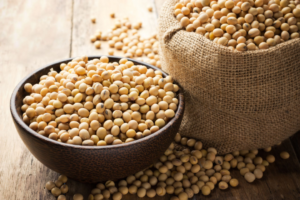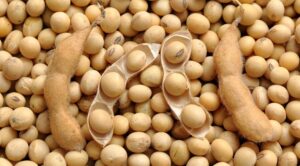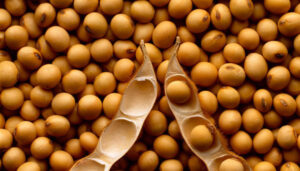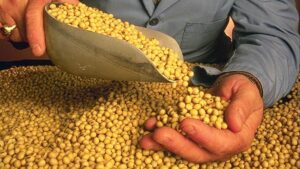
Ukraine is expected to increase soybean production in 2024.
“Ukroliaprom” estimates the soybean harvest in the season-2024 at 6.1 million tons, which is 28% more than a year earlier. The association attributes such growth to a significant increase in production areas – by 46.6% to 2.66m hectares.

The Ukrainian soybean market is showing outstanding results – exports since the beginning of 2024-2025 marketing year (July-June) amounted to 445 thsd tonnes, which creates preconditions for a new record, according to the analytical cooperative “Start”, created within the framework of the All-Ukrainian Agrarian Council.
The analysts emphasized that despite the pace of exports, the Ukrainian market depends on global trends, such as fluctuations in prices for American and Brazilian soybeans.
“Ukrainian soybeans are usually sold at a discount compared to US soybeans, which is about $5-7 per ton. However, now the price of US soybeans is almost equal to the Ukrainian one, which is a favorable signal for domestic exporters. Negative trends in the physical markets, in particular, the fall in the price of soybeans in Chicago, have not yet affected our sales volumes,” the experts said.
They pointed out that seasonal trends indicate a possible increase in soybean prices in December-March, which is traditionally an active period for trade. Prices for soybeans will gradually rise to $420-440 per ton, which is $20-30 more than the current figures, according to Pusk.
“December is always active for the market due to the preparation for the Christmas holidays. Processing companies will increase purchases of soybeans, as most of them have covered their needs only for the first half of December. This creates high demand, which, in turn, will contribute to the price increase,” the experts explained and recommended producers who have the opportunity to postpone sales until February-March to maximize the benefits.
On the domestic market, prices for soybean meal remain low, which limits the ability of processors to set high purchase prices. So far, they are buying soybeans for 17.3-17.5 thousand UAH/t. However, the correlation between the price of soybeans and meal gives us hope for the situation on the Ukrainian market to level off in the coming months, Pusk summarized.

The harvest of corn, according to preliminary estimates of the Ministry of Agrarian Policy and Food, in 2024 will be 25 million tons, sunflower – 12 million tons, soybeans – 5 million tons, said Minister of Agrarian Policy and Food Vitaly Koval in an interview with Forbes Ukraina.
“Ukraine did not receive about 2% of early grains compared to last year’s harvest. This group did not suffer as much as late crops. Soybeans, buckwheat, corn and sunflower suffered the most. They have a shortfall of about 10-15% depending on the region. However, this is not critical for the food security of the country,” he said.
Koval expressed confidence that in the new season the structure of crops will not change globally compared to last year. At the same time, the Ministry of Agrarian Policy has concerns about winter rape: there is not enough moisture to sow it.
“In total, about 5 million hectares of winter crops will be sown,” summarized the Minister of Agrarian Policy.

The exports of soybeans from Ukraine in the season-2023/2024 reached the record level and amounted to about 3.26 mln tonnes, up 5% from the previous high of 3.1 mln tonnes in 2022/2023 MY, APK-Inform news agency reported.
“The increase in shipments was achieved due to several factors, including the significant increase of the crop harvest in 2023 and the competitive price of Ukrainian soybeans on the global market, particularly in the first half of 2023/24 MY. Thus, in September-February of the last season, the country shipped almost 70% of the total exports of soybeans,” the analysts said.
According to APK-Inform, in 2024/2025 MY Ukraine will export about 3.5 mln tonnes of soybeans, up 7% compared to the last season.
According to them, the increase in exports was mainly due to Egypt (2.1 times more), while shipments to the EU and Turkey decreased by 22% and 26%, respectively.
Experts predict that in the new season-2024/2025, Ukraine has a chance to update the record for soybean exports, given the forecast of an increase in the harvest of this crop to almost 6 million tons, which is 10% more than last year. At the same time, due to the expected increase in global soybean production, it will be harder to compete with prices in the new season, especially in such destinations as Egypt and Turkey.
According to the results of the season-2023/2024, the demand prices for Ukrainian soybeans decreased by an average of $120/ton in line with the global market dynamics and due to the increased competition. Comparing the price levels as of the end of August, this year Ukrainian soybeans of the new harvest are offered to Egypt at $427/ton CIF, while last year in the same period the supply prices on the same basis reached $545-550/ton.

As of June 3, soybean exports from Ukraine slowed down and amounted to only 1500 tons, while significant stocks of 700-800 thousand tons remain in warehouses, according to the analytical cooperative “Start”, created within the framework of the All-Ukrainian Agrarian Council (AAC).
“The soybean market is now in the off-season period, when the activity is significantly reduced. The main liquidity is currently provided by processors who maintain a high level of demand for raw materials. The average purchase price from processors already exceeds 19 thousand UAH/ton, and further price growth can be expected. Soybean exports are expected to remain weak in the coming months. Most of the transactions are made for cash. This also affects the volume of supplies abroad. On the stock market of soybeans, we are likely to see the downward trend reversal and attempts of growth,” the analysts said.
The experts also added that despite the overall weakness of exports, there are positive signals from the Polish market.
“Polish companies are showing considerable interest in Ukrainian soybeans. On the border with Poland, soybean prices are $410-415/ton. In the ports, the conditional prices on CPT basis are about $435-440/ton,” the UAC stated.

In 2024, the production of oilseeds in Ukraine will increase by 19% compared to 2023 to 2.3 mln ha, which will be a record for the industry, APK-Inform news agency reported based on the results of the survey among farmers.
According to the survey, conducted in February-March 2024, 82% of the respondents, who grow soybeans, plan to keep the area under soybeans unchanged, and 16% intend to increase it. The increase will be due to the reduction of the area under winter crops, as well as sunflower or other spring crops.
The soybean area in 2024 may increase to 2.3 mln ha (+19% by 2023), which will be a new record for the industry. Previously, the maximum for this crop was 2.2 mln hectares in 2015, analysts predict.
They also expect the production of soybeans in Ukraine to reach a record level, which, according to preliminary estimates, could reach 6 mln tons, which is 17% higher than last year.
At the same time, according to experts, the area under sunflower is not likely to change significantly: 87% of the respondents who grow the crop plan to keep the area under it unchanged. Those who plan to reduce or increase the area under sunflower mostly reported that it will be at the expense of rapeseed.
“Our estimate of the sunflower acreage in 2024 is still 5.8 mln ha, which is almost at the level of 2023. Under favorable weather conditions, the oilseed harvest could reach 13.9 mln tonnes (+1% compared to 2023), which is still lower than the pre-war figure,” the analysts emphasized.
The area under rapeseed in 2024 is likely to decrease due to the dry autumn, which led some farmers to abandon the winter oilseed planting.
In the survey, 51% of respondents reported that winter rapeseed crops are in good or excellent condition, 43% – in satisfactory condition, and 5% – in poor condition.
The area under spring rapeseed may also increase in 2024 to the record level due to the price attractiveness of this oilseed, but the total area under winter and spring rapeseed, according to APK-Inform preliminary estimates, will decrease by 6%. This figure will still remain quite high compared to previous years, amounting to about 1.4 mln ha. The harvest of this oilseed may decline by 9% in 2024, to 4.2 mln tonnes, APK-Inform summarized.